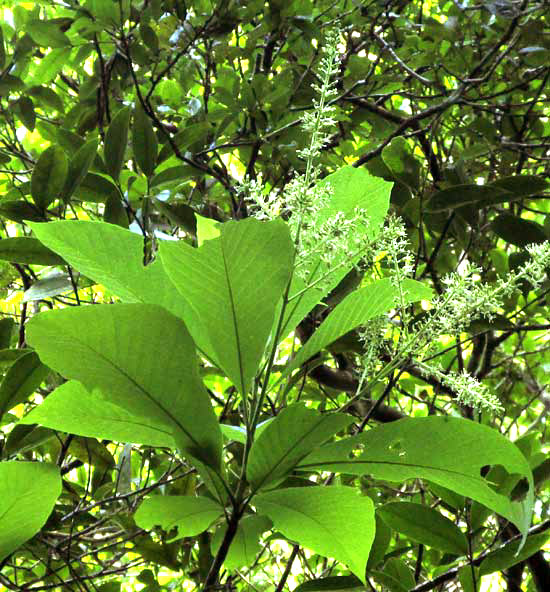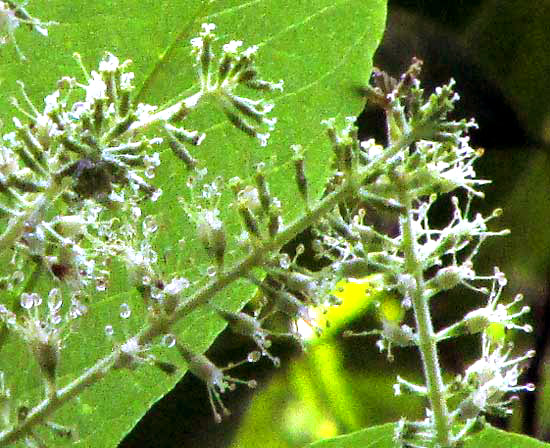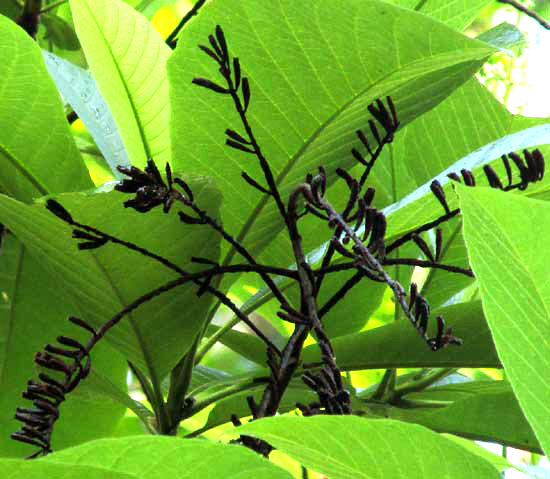Excerpts from Jim Conrad's
Naturalist Newsletter
from the July 31, 2016 Newsletter issued from Hacienda Chichen Resort beside Chichén Itzá Ruins; limestone bedrock; elevation ~39m (~128ft), N20.675°, W88.569°; central Yucatán state, MÉXICO
WILD MAMEY

In deep forest I was visiting an isolated cenote, or sinkhole. It was so deep and its sides so steep that I couldn't explore it much looking for interesting organisms, but along its steeply sloping rim there grew a tree I'd not seen. It was a fine looking one with big, tongue-shaped leaves reminiscent of those on understory umbrella magnolias up North. The trees were so entangled with surrounding vegetation that no portrait was possible, but there was something better: A few top branches bore large clusters of flowers. The flowers were so high they couldn't be reached, but one flowering branch was in sunlight and my little telephoto lens was able to capture the image at the top of this page.
Important field marks seen at this distance include the fact that the fairly large leaves are broadest toward their tips, or "obovate," that they have numerous, ±straight and parallel veins, they tend to cluster at branch tips, and -- from what's seen in the above picture -- they look to be "alternate," to arise one leaf per stem node. Also, the flower cluster is of the panicle type.
Pushing both my little telephoto lens and PhotoShop to their limits, I got the somewhat grainy but closer-up view of some flowers, still wet from nighttime rains, shown below:

In that picture, flowers on the right each bear five stamens extending well above the other parts, while on the left most flowers instead of stamens bear wishbone-shaped stigmas atop ovaries. These blossoms give the impression of being unisexual flowers on the same tree. Most important, however, is the detail best seen on the stigma-bearing blossoms at top left -- that the ovaries are "inferior." Inferior ovaries are those with their calyx, corolla, stamens, styles and anthers arising at their tops, while superior ones have those items arising below the ovary. Since a minority of flower types have inferior ovaries, this is a great field mark eliminating many possibilities.
Last year's dark fruiting clusters remained on one or two branches, and one is shown below:

In that picture the fruit shapes -- thicker at their tops and topped by crown-like calyxes -- confirms that the flowers' ovaries are inferior.
However, it also shows that in some places along the stem -- as toward the lower, right -- leaf petioles appear to arise opposite one another, making the leaves opposite instead of alternate. And on the stem at the lower left, they appear to arise more or less haphazardly. Now I wasn't sure whether leaves were opposite or alternate.
It took awhile to identify this distinctive tree because apparently the flowers are not unisexual. It must be that the flowers' male and female parts mature at different times, as often is the case, thus avoiding self pollination. Still, the inferior ovaries limited the possible families involved. In the American tropics, the most commonly encountered plant family with woody trees bearing flowers with inferior ovaries and five stamens is the Coffee or Madder Family, the Rubiaceae, and that's where I found our tree.
It's ALSEIS YUCATANENSIS, sometimes called Wild Mamey in English-speaking Belize, because the leaves look like the Mamey's, though the fruits are anything but like them. Wild Mamey seems to be endemic just to southern Mexico, Belize and northern Guatemala. Despite the leaf arrangements observed in our pictures, the literature describes Wild Mamey as having opposite leaves, which is the normal state for members of the Coffee Family.
Not much is known about Wild Mamey. My impression is that our pictures and notes about it growing in the wild add a good bit to what's available about it.